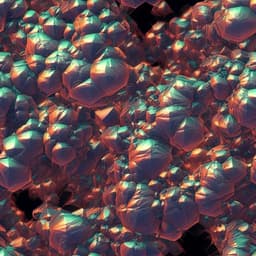
Engineering and Technology
High-energy and durable lithium metal batteries using garnet-type solid electrolytes with tailored lithium-metal compatibility
S. Kim, J. Kim, et al.
Exciting advancements in lithium metal batteries utilizing solid electrolytes have been achieved by authors Sewon Kim, Ju-Sik Kim, Lincoln Miara, Yan Wang, and others. Their research showcases tailored garnet-type Li7-xLa3Zr2-yO12 solid electrolytes that significantly enhance stability and energy density, paving the way for commercial applications in the future.
~3 min • Beginner • English
Introduction
The study addresses the central challenge limiting practical lithium metal batteries with solid electrolytes: chemical and electrochemical instability at the Li/solid-electrolyte interface, which leads to interfacial degradation, electronic leakage pathways, and lithium penetration/short-circuiting. Garnet-type LLZO is a leading oxide solid electrolyte but exhibits dopant-dependent reactivity with lithium metal and surface contaminants (e.g., Li2CO3) that elevate interfacial impedance. The research question is how to tailor LLZO composition and interfaces to achieve long-term Li-metal compatibility at high current density and high cathode areal capacity. The authors hypothesize that coupling bulk dopant selection with targeted, dopant-specific interfacial modification (protonation via acid treatment) can shift reduction by-products toward electronically insulating, ionically conducting phases that passivate the interface, while simultaneously improving surface morphology and mechanics, thereby enabling durable, high-rate, high-capacity cycling meeting commercial requirements.
Literature Review
Prior work has established LLZO as a fast Li-ion-conducting garnet with promise for solid-state batteries, but intergranular lithium propagation and dendrite formation have been widely reported, especially in polycrystalline pellets. Studies highlight roles of electronic conductivity surges in LLZO, grain boundary pathways, surface Li2CO3 contamination raising interfacial resistance, and various interlayer or interface modification strategies to mitigate short circuits. Dopant choice in LLZO (e.g., Ta, Al, Nb, Ga/W) affects both ionic conductivity and thermodynamic stability against Li; few dopants remain stable against lithium, and metallic by-products can form, compromising passivation. Li+/H+ exchange in garnets is known and has been shown reversible, and acid treatments have been used to remove Li2CO3 and reduce interfacial impedance. However, a comprehensive, dopant-specific strategy coupling bulk dopant effects with targeted interfacial chemistry to generate insulating passivation products during reduction had not been fully realized. This work builds on DFT thermodynamic analyses and prior interface engineering reports to propose protonation/etching tailored to primary dopants to create favorable, passivating interphases.
Methodology
Materials synthesis: Ta-, Al-, Nb-, and Ga/W-doped LLZO were prepared via solid-state synthesis from Li2CO3, La2O3 (pre-dried), and ZrO2 with dopant oxides (Ta2O5, Al2O3, Nb2O5, Ga2O3, WO3). Powders were calcined (950 °C, 5 h; then 1200 °C, 5 h), ball-milled repeatedly, and hot-pressed (1100 °C, 2 h, 20 MPa, Ar). Discs (~14 mm) were cut and polished to ~350 µm thickness. Protonation/interfacial tailoring: Pellets were immersed in 1 M HCl at room temperature (rolling at ~60 rpm) to induce Li+/H+ exchange primarily at grain boundaries and near-surface regions, then washed and dried. Protonation was confirmed by TGA (H release around 450 °C). Surface Li2CO3 removal and morphology changes were characterized by XPS and SEM; mechanical properties assessed by ring-on-ring tensile strength tests. Structural characterization: XRD (Cu Kα) including high-resolution scans for Rietveld refinement to quantify cubic vs. tetragonal phase near surfaces; TEM with SAD to probe surface-phase crystallography and strain. Electrochemical characterization: EIS (0.1–10 kHz, 10 mV) at 25 and 60 °C on Li/LLZO/Au and Li/LLZO/Li cells; galvanostatic symmetric Li/LLZO/Li cycling at 0.2 mA cm−2; critical current density (CCD) measurements by stepwise plating/stripping (0.1→3.0 mA cm−2). Electronic conductivity measured via DC polarization (Hebb–Wagner) at 60 °C. Chemical colorization tests: Contact with Li at 200 °C under 250 MPa, monitoring discoloration, Li penetration, and XRD before/after. DFT calculations: Thermodynamic grand potential phase diagrams for doped and protonated-doped LLZOs against Li reservoir; predicted reduction products and electrochemical stability windows to evaluate likelihood of metallic vs. insulating by-product formation upon reduction. Full-cell tests: Hybrid solid-state cells used LLZO as anolyte with Li metal and an ionic liquid catholyte (2 M LiFSI in Pyr13FSI) infiltrated into NCM111 cathodes (3.2 mAh cm−2); cycling protocols at 60 °C and 100 °C with stepwise rate increases. High-loading NCM811 cathodes (6.4 mAh cm−2) tested at 60 °C. Long-term cycling: NCM111/LLZO/Li hybrid cells with 2.0 and 3.2 mAh cm−2 cathodes at 3.0 and 1.6 mA cm−2, respectively. Thin (~110 µm) tape-cast LLZO tested. All-solid-state cells: Composite NCM811 cathode with Li2PSCl solid electrolyte paired with protonated Ta-LLZO (no liquid) cycled at 3 mA cm−2.
Key Findings
- Dopant-dependent chemical stability against Li: Visual colorization tests and XRD/EDS/SIMS indicated Ga,W- and Nb-LLZO undergo rapid degradation, Li penetration through grain boundaries, loss of crystallinity, and formation of reduced phases; Ta- and Al-LLZO appear more stable macroscopically but still form Li2ZrO3 and ZrO2 locally upon Li contact.
- Electrochemical impedance and symmetric-cell cycling mirrored chemical stability: Ta- and Al-LLZO showed minor interfacial impedance growth and stable 0.2 mA cm−2 cycling at 60 °C, whereas Nb- and Ga,W-LLZO showed substantial impedance changes and unstable cycling.
- DFT thermodynamics: All dopants reduce LLZO stability vs. undoped LLZO, with trend of decreasing stability Ga,W > Nb > Ta > Al. Reduction produces electronically conducting by-products (e.g., Ta, Al3Zr, W/Ga metal, LiNbO2→Nb, Zr3O), preventing passivation. Co-doping with protons predicted insulating, ionically conducting by-products for Ta- and Al-doped systems (La(OH)3, LiOH, and notably Li5TaO4 around ~1.0 V), enabling interfacial passivation; Nb+H predicted Li9Nb2O9 (mixed conductor), less effective.
- Protonation via acid treatment selectively stabilizes interfaces and grain boundaries: Protonated Ta- and Al-LLZO showed higher stability against Li than pristine counterparts; Nb- and Ga,W-LLZO remained unstable, consistent with DFT predictions.
- Electronic conductivity suppression: Protonated Ta-LLZO electronic conductivity decreased from ~1.5×10−9 to ~5×10−10 S cm−1 (Hebb–Wagner, 60 °C); Nb-LLZO showed no significant change.
- Interfacial resistance reduction: Li/Ta-LLZO/Li interfacial resistance dropped from ~35 Ω·cm2 (pristine) to ~0.9 Ω·cm2 (protonated) at 25 °C. XPS confirmed removal of surface Li2CO3 to only a few-nm outermost layer.
- Surface morphology and mechanics: Acid etching generated a more uniform rough/porous interface, removing sharp defects that can initiate Li penetration; tensile strength increased from 86±14 MPa to 134±7 MPa. Near-surface tetragonal LLZO fraction (∼57.6 wt% in pristine) was eliminated post-treatment (to ∼97.2 wt% cubic), reducing lattice strain from ~0.509% to ~0.076%.
- Critical current density (CCD): At 60 °C, CCD increased to ~2.6 mA cm−2 (protonated Ta-LLZO) and ~2.0 mA cm−2 (protonated Al-LLZO); at 25 °C, ~1.6 mA cm−2.
- Full-cell performance at 60 °C (hybrid catholyte): NCM111/protonated Ta- or Al-LLZO/Li sustained stepwise rates up to 3 mA cm−2 without short-circuit. Rate retention at 3 mA cm−2 was ~93% (Ta) and ~63% (Al) vs. initial at 0.5 mA cm−2.
- High-loading cathode: NCM811 (6.4 mAh cm−2) with protonated Ta-LLZO delivered 87% of nominal capacity at 1.6 mA cm−2 with ~99.7% Coulombic efficiency after 100 cycles.
- High-temperature operation (100 °C): Protonated Ta-LLZO reached limiting current density >10 mA cm−2 and cycled 100+ times at 6 mA cm−2 delivering 96% of 3.2 mAh cm−2 with 99.6% CE; protonated Nb-LLZO failed; protonated Al-LLZO showed inferior rate capability at high currents.
- Long-term cycling: Hybrid NCM111/protonated Ta-LLZO/Li cells maintained 2000 cycles at 3 mA cm−2 with 2.0 mAh cm−2 and 1000 cycles at 1.6 mA cm−2 with 3.2 mAh cm−2, with average CE >99.83% and ~99.92% at the 1000th cycle.
- Thin electrolyte: ~110 µm protonated Ta-LLZO achieved >600 cycles at 2 mA cm−2 without short circuit (slightly reduced capacity vs. thicker pellets).
- All-solid-state cell (no liquid): Composite NCM811 (5 mAh cm−2)/protonated Ta-LLZO cycled >1000 times at 3 mA cm−2 without short-circuit.
- Record cumulative capacities: Hybrid full cells achieved cumulative Li plating capacities up to 4000 mAh cm−2 at 3 mA cm−2 (5 mAh cm−2 all-solid-state and 2–3.2 mAh cm−2 hybrid configurations), exceeding practical benchmarks for garnet-based Li-metal batteries. Projected volumetric energy densities: ~428–470 Wh L−1 depending on configuration.
Discussion
The results confirm that Li-metal compatibility of LLZO is highly dopant-dependent and can be substantially improved by coupling bulk dopant selection with protonation-based interfacial tailoring. DFT-guided co-doping predicts and experiments validate that protonation of Ta- and Al-doped LLZO shifts reduction pathways toward electronically insulating, ionically conducting by-products (e.g., Li5TaO4 and hydroxides), which passivate further decomposition and suppress electronic pathways that enable Li penetration. Simultaneously, acid treatment removes Li2CO3, reduces interfacial resistance, creates a more uniform, defect-mitigated surface with increased effective contact area, and improves mechanical robustness by eliminating near-surface tetragonal phases and relieving lattice strain. These synergistic effects yield large gains in CCD, high-rate stability, and unprecedented long-term cycling at high areal capacities and current densities, including at elevated temperature. The dopant-specific nature of the approach is underscored by the limited efficacy for Nb- and Ga/W-doped LLZO, where predicted mixed/metallic products fail to passivate. Overall, the findings directly address the interfacial instability challenge, translating to practical cycling parameters that meet or exceed industrial requirements for solid-state Li-metal batteries based on garnet electrolytes.
Conclusion
This work demonstrates a dopant- and interface-tailoring strategy for LLZO solid electrolytes that enables high-energy, durable Li-metal batteries. Guided by DFT thermodynamics, protonation of Ta- and Al-doped LLZO selectively forms insulating, ionically conducting interphases upon reduction, reduces interfacial impedance by removing Li2CO3, improves surface morphology and mechanical strength, and suppresses lithium penetration. The approach delivers record-high cycling parameters for garnet-based systems, including CCDs up to ~2.6 mA cm−2 at 60 °C, stable operation up to >10 mA cm−2 at 100 °C, long-term cycling over 1000–2000 cycles at practical areal capacities (2–6.4 mAh cm−2), and cumulative capacities ≥4000 mAh cm−2, including in an all-solid-state configuration without liquid electrolyte. These advances indicate the feasibility of garnet-based solid-state Li-metal batteries for practical applications. Future work should optimize protonation depth and distribution, explore other synergistic secondary dopants or interphases tailored to primary dopants, scale to thinner dense electrolytes with controlled surfaces, and extend the strategy to other solid electrolytes and high-loading cathodes.
Limitations
- Efficacy is dopant-specific: Protonation effectively stabilizes Ta- and Al-doped LLZO but not Nb- or Ga/W-doped LLZO, limiting generality across compositions.
- Mechanistic uncertainty: It remains unresolved whether acid treatment removes a tetragonal secondary phase by chemical etching and/or induces a tetragonal-to-cubic transformation via Li redistribution; the precise mechanistic pathway warrants further study.
- Potential trade-offs: While designed to be surface-limited, protonation/etching could impact near-surface ionic conductivity; careful control is required to balance stability and conductivity.
- Hybrid cell configuration: Many high-rate and long-cycle tests use an ionic liquid catholyte for cathode contact; although an all-solid-state demonstration is provided, broader validation across fully dry interfaces and diverse cathodes is needed.
- Thin electrolyte performance: The ~110 µm electrolyte showed slightly reduced capacity vs. thicker pellets due to different surface properties, indicating surface/process sensitivity in scaled configurations.
Related Publications
Explore these studies to deepen your understanding of the subject.







